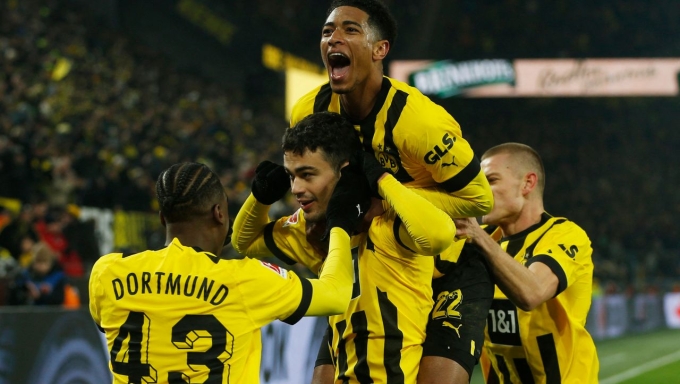Những nhân tố giúp Dortmund trỗi dậy
Thời gian phát hành 2025. 07. 04. 15:03

rand appeal. 5. Financial Discipline Unlike clubs burdened by debt, Dortmund practices strict financial management. It avoids exorbitant wages, reinvests transfer profits, and adheres to financial fair play (FFP) rules. This discipline ensures long-term stability, allowing the club to compete without overextending resources. 6. Stable Leadership Long-serving figures like CEO Hans-Joachim Watzke and sporting director Michael Zorc provide strategic continuity. Their consistent vision—balancing ambition with pragmatism—prevents the chaotic management shifts that hinder many clubs. 7. Infrastructure & Support Systems State-of-the-art training facilities (e.g., the Westfalenstadion and BVB Campus) and world-class medical staff support player development and fitness. These resources attract top talent and ensure sustained performance. 8. Scouting Network Dortmund’s global scouting network identifies hidden gems early, from local German talent (Marco Reus) to international stars (Haaland from Norway, Bellingham from England). This network ensures a steady pipeline of promising players. 9. Competitive Bundesliga Environment The Bundesliga’s FFP regulations and relative parity (compared to leagues like the Premier League) allow Dortmund to challenge Bayern Munich and others without matching their financial might. This competitive balance supports Dortmund’s sustainable model. 10. Player Mentality & Ambition Young players at Dortmund are driven to excel, seeing the club as a stepping stone to top European teams. This hunger fuels high performance, creating a virtuous cycle where success attracts more talent. In summary, Dortmund’s resurgence is a product of aligning youth development, smart business, tactical identity, and fan culture—creating a model of sustainable success in modern football.
Liên quan
- [Coppa Italia] 02h00 ngày 20/01: Inter vs Lazio
- [Tin khác] Newcastle dọn đường để Isak tới Liverpool
- [V-League] HAGL bị đẩy trở lại cuộc đua trụ hạng ở V-League
- [Thể thao] Sinner và Djokovic chung nhánh Wimbledon 2025, Alcaraz gặp Fognini ở vòng 1
- [Điểm tin] Tin giờ chót 24/9: Arteta phản pháo sau khi bị Haaland chế giễu
- [Thể thao] Nguyễn Thị Oanh lập kỷ lục 5000m, khẳng định đẳng cấp 'nữ hoàng điền kinh'
- [Điểm tin] Tin giờ chót 24/10: Man City tan hoang lực lượng
- [Đội tuyển Pháp] KFC xin lỗi Mbappe và tuyển Pháp
- [Cúp Quốc gia Đức] Sao Hàn Quốc tỏa sáng, Leipzig vào bán kết Cúp QG Đức
- [Đội tuyển Italia] Sát thủ săn bàn, nỗi ám ảnh của người Italia
- [VĐQG Tây Ban Nha] 02h00 ngày 24/5: Betis vs Valencia
- [Đội tuyển Đức] ĐT Đức: Gnabry tìm lại chính mình
- [Bundesliga] HLV Dortmund đau đớn vì mất chức vô địch Bundesliga
- [Coppa Italia] 00h30 ngày 4/12: Bologna vs Monza
- [Đội tuyển Pháp] ĐT Pháp: Dembele mở đường tới EURO
- [Bundesliga] Muller giúp Bayern thắng dễ
- [Đội tuyển Italia] ĐT Italia: 'Họng súng' Be-Be
- [Tin khác] Racing Club thắng kèo châu Á, Flamengo đè phạt góc
- [VĐQG Pháp] 02h00 ngày 11/5: Monaco vs Lyon
- [VĐQG Tây Ban Nha] Messi còn phải chào thua Lewandowski
- [U21 Quốc Gia] Nutifood vô địch U21 Quốc gia 2021, thầy Công Phượng vô địch
- [Đội tuyển TBN] Tiền vệ Liverpool 'hết cửa' dự World Cup 2022?
- [U19 Quốc Gia] Chủ tịch SLNA dùng 4 từ để miêu tả phẩm chất của Văn Quyết
- [Cúp Nhà Vua] 03h30 ngày 27/2: Sociedad vs Real Madrid
- [V-League] Hà Nội FC lần đầu lên nhì bảng V-League 2023-2024
- [V-League] Nguyễn Tuấn Anh ký hợp đồng với Nam Định
- [Đội tuyển Đức] Havertz nhận 'gạch đá' vì 'lên lớp' người hâm mộ
- [VĐQG Đức] Chính thức! Ten Hag tái xuất, dẫn dắt Leverkusen
- [Cúp Nhà Vua] Real tổng tấn công lực lượng... trọng tài
- [Tin khác] Real Madrid đón tân binh thứ 4 với mức giá bất ngờ
- [VĐQG Tây Ban Nha] Barca đã bắt đầu hoàn thiện 'dream team' tương lai
- [Đội tuyển Pháp] Giroud bóng gió thời điểm chia tay ĐT Pháp
- [Bundesliga] Liverpool đồng ý bán Mane cho Bayern
- [Giao hữu] 21h00 ngày 20/7: QPR vs Tottenham
- [Giao hữu] Stones chấn thương, ĐT Anh thua đơn thiệt kép
- [Cúp Nhà Vua] Thần đồng của Barca lập siêu phẩm chẳng kém gì Messi
- [V-League] Hà Tĩnh hạ HAGL ở V-League
- [Đội tuyển Đức] Hansi Flick xứng đáng bị sa thải từ lâu!
- [Đội tuyển Italia] Luciano Spalletti được bổ nhiệm làm HLV ĐT Italia thay Mancini
- [Bundesliga] Abramovich 'bật đèn xanh' cho Chelsea mua Haaland
- [Coppa Italia] 3h15 ngày 22/1: Lazio vs Parma
- [VĐQG Tây Ban Nha] Cả châu Âu 'đi câu' ở lò trẻ Real Madrid
- [V-League] HLV Hải Phòng trách học trò mất tập trung khi thua Nam Định
- [Giao hữu] Messi bị đau vẫn phải vào sân chịu sỉ nhục, Ronaldo cười vui trên khán đài
- [U19 Quốc Gia] Những cựu thành viên U16 Việt Nam đã chơi thế nào?
- [Thể thao] 'Nữ hoàng thể hình' qua đời bí ẩn trong hồ bơi khách sạn tại Mexico
- [Thể thao] Novak Djokovic chạm mốc 100 chiến thắng tại Wimbledon: 'Tôi vẫn đang cống hiến như ngày đầu!'
- [Bundesliga] Leverkusen thiếu nơi mừng chức vô địch
- [Coppa Italia] Abraham, Shomurodov đưa Roma vào tứ kết
- [Điểm tin] Tin giờ chót 29/4: Santiago Solari dẫn dắt Real Madrid ở FIFA Club World Cup